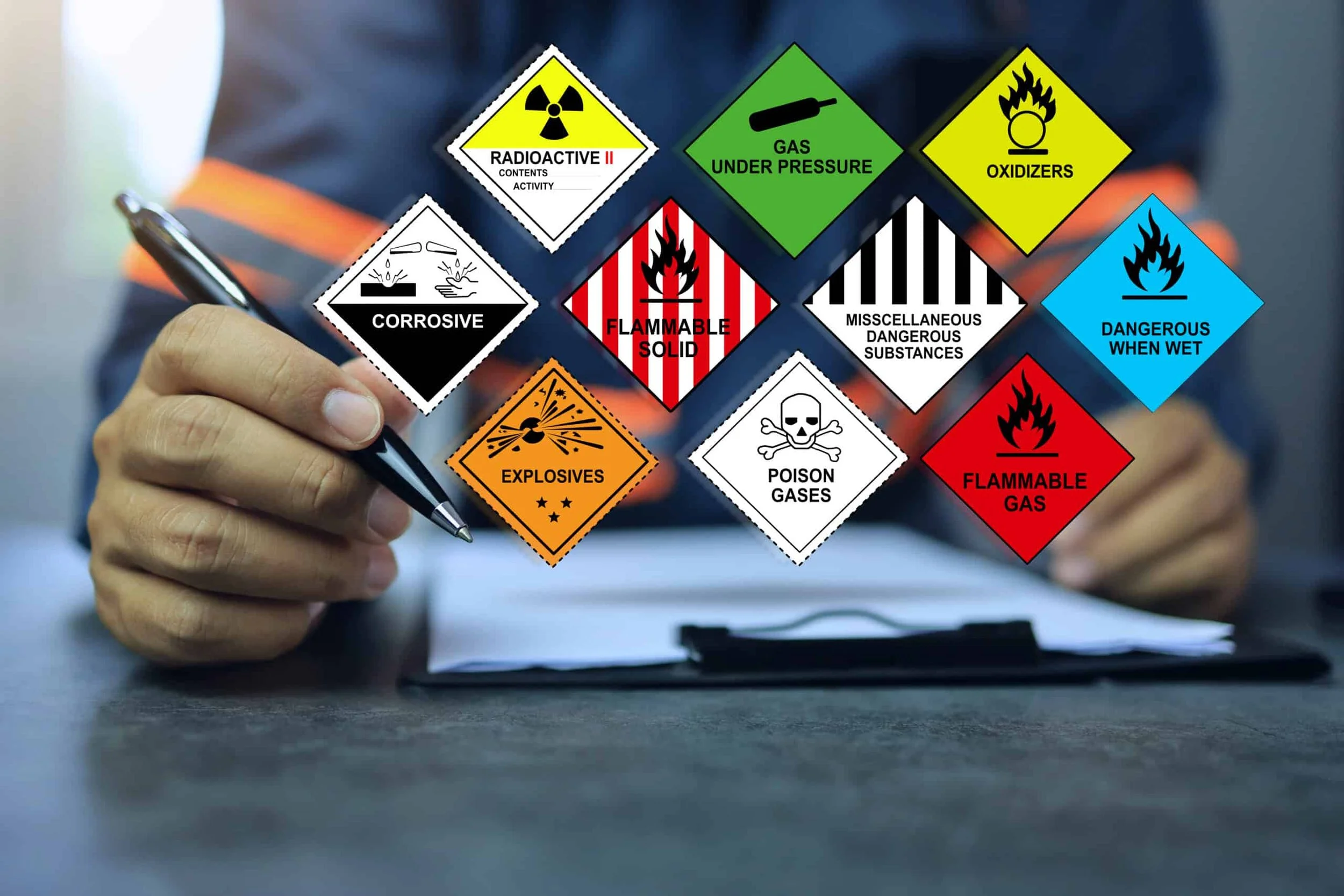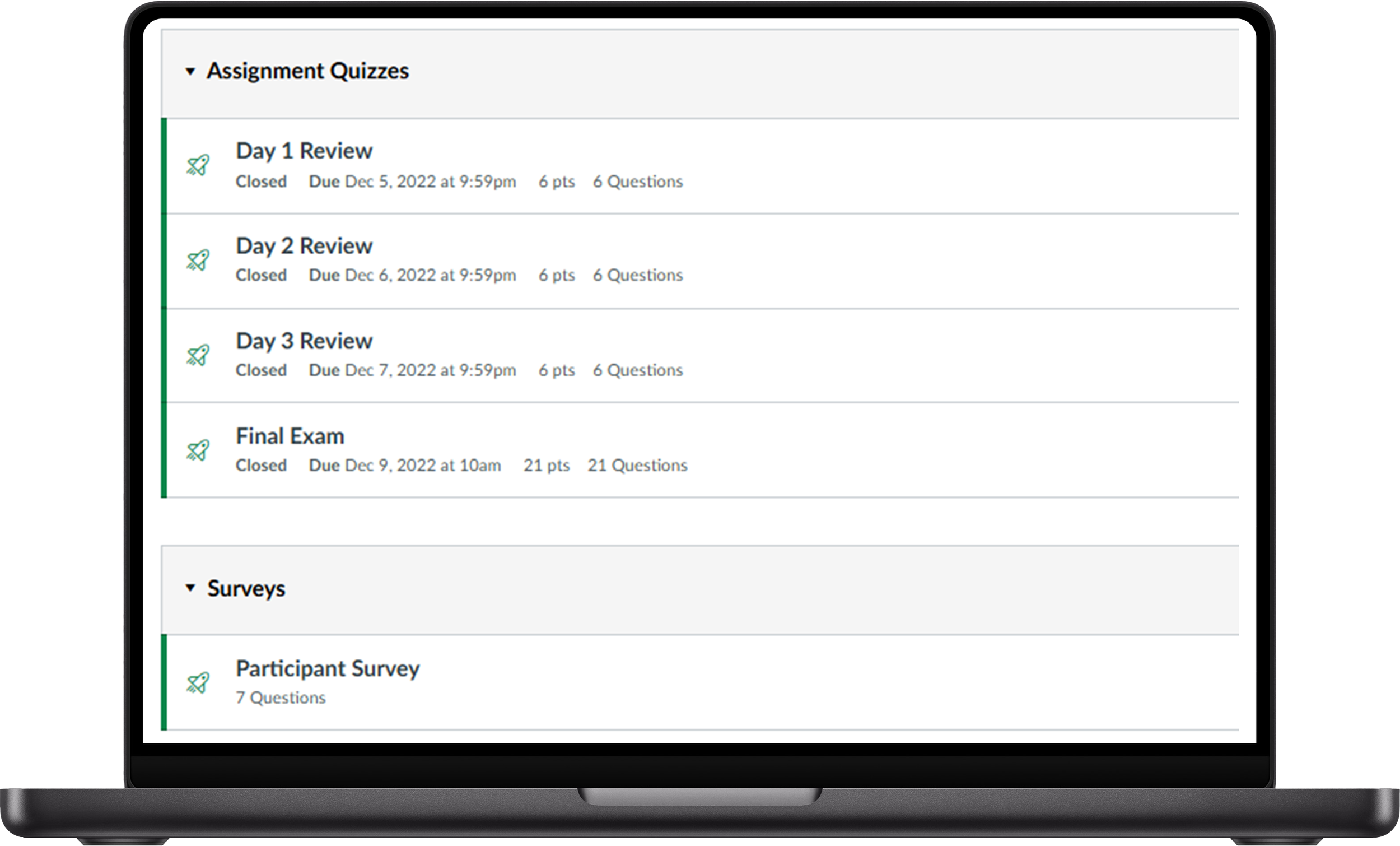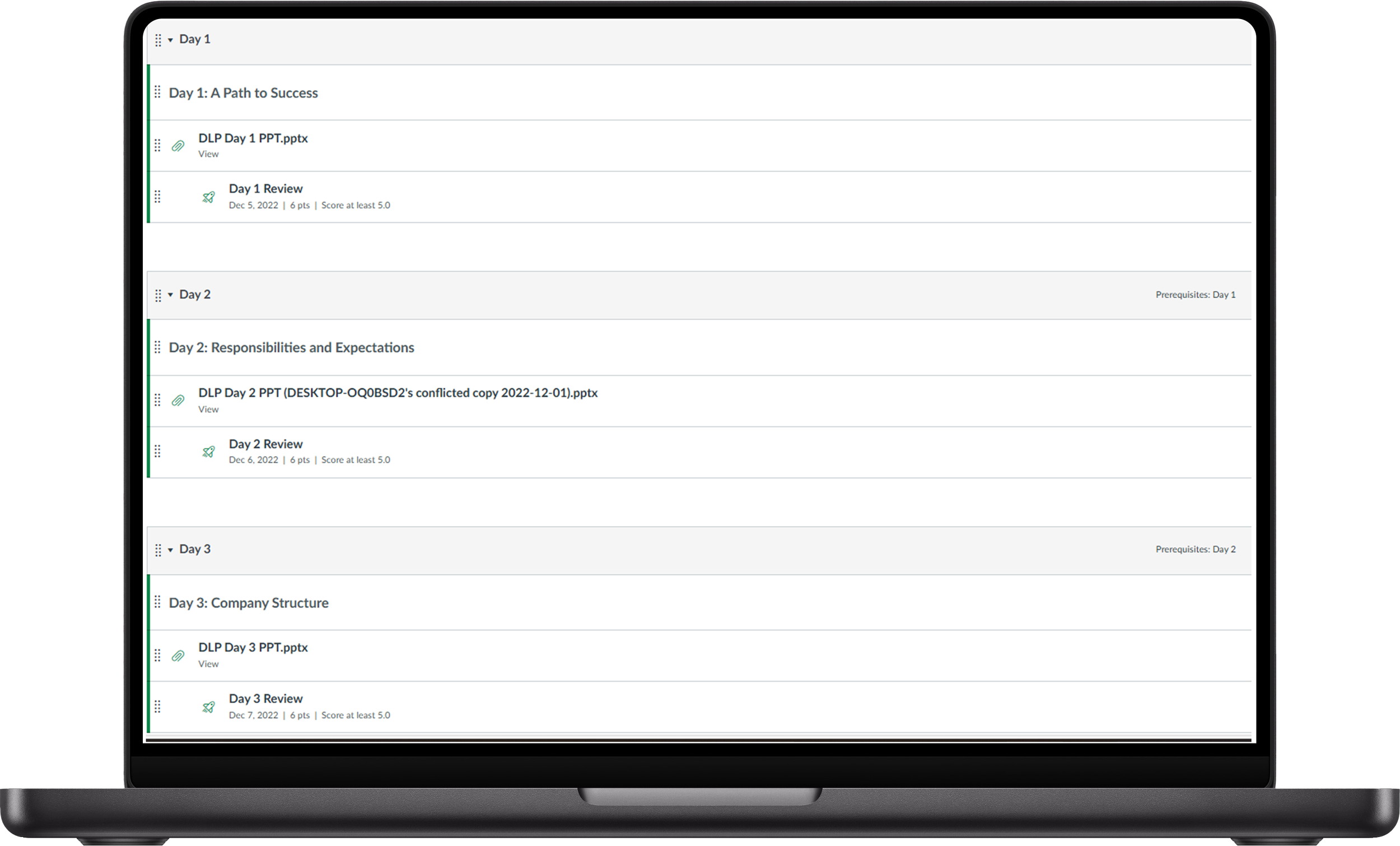DLP
SUMMARY
This program was constructed as a final project for my 'Human Resources Training' course during my Industrial-Organizational Psychology master’s program. For this project, we were tasked with creating an asynchronous training based on an existing or formulated organizational need. The project consisted of conducting a needs assessment, designing learning objectives, integrating multimedia into PowerPoint slides, and applying instructional theories to construct and evaluate the effectiveness of the training. The final course was then uploaded into Canvas, where we, as instructors and creators, explained our process and organized materials accordingly.
THE PROBLEM
For this project, I reimagined UPS’s package handler onboarding program, drawing from my firsthand experience as a seasonal employee. I identified three primary areas for improvement.
First, the training’s short duration (3 days) was insufficient for information provided. New hires were expected to absorb complex material quickly, but the lack of reinforcement opportunities made it difficult to retain key concepts.
Second, the training materials lacked engaging design elements. The slides and videos used were monochromatic, text-heavy, and repetitive, failing to capture attention or support different learning styles.
Lastly, despite the training being in-person, there was minimal interactivity, relying primarily on passive instruction with limited hands-on practice or knowledge checks. Without active engagement, employees stated that they struggled to apply what they had learned effectively.
With these factors in mind, I developed a revised onboarding program with enhanced structure, engagement, and interactivity to improve knowledge retention, motivation, and overall training effectiveness.
THE SOLUTION
To begin by addressing the timeframe, I extended my version to 5 days total. The first three days covered content, Day 4 would be a review day for the participants, complete with a study guide to review materials before their final exam, and Day 5 would be the final exam day. By extending the previously mentioned timeline slightly, I believe the content is more easily digestible and allows participants to not feel rushed to learn such vital information to the organization’s success, while still having participants ready to start work in a timely manner.
To improve engagement, I added several elements. First, I enhanced the slides with brighter, more vivid colors, replacing the flat monochromatic design of the previous presentations. Second, each day’s worth of content had a different themed slideshow to accommodate that day, which in turn, would encourage more engagement. As we know from Mayer’s Cognitive Theory of Multimedia Learning (Mayer, 2005), a dynamic form of training that coordinates text and other forms of media has positive effects on participants’ engagement and retention of information post-training.
Lastly, for interactivity, I introduced integrated learning objectives with “SMART” goals in mind (Smith, 2019) and quizzes for each lesson to help participants review and retain the information that they learned for that day, which was lacking from the previous training. Additionally, a review section was added starting with the Day 2 presentation to help participants review content from the day prior. On Day 4, the entire presentation is dedicated to review, which combines content from Days 1, 2, and 3. As we know from Ebbinghaus’s foundation “Spacing Effect” theory (Ebbinghaus, 1964), repeated reinforcement of content over a shorter period of time has been shown to have positive effects on participant retention of that information.
THE PROCESS
To create a structured, engaging, and effective training program, I followed a systematic process that ensured logical content progression and knowledge reinforcement.
IDENTIFYING ESSENTIAL TOPICS
I began by compiling a comprehensive list of essential topics based on my firsthand experience with the previous training program. This included not only the key learning objectives but also additional information that would have enhanced the prior training experience. For example, I incorporated an overview map of the facility and guidance on which bus to take from the security center to specific work locations.
ORGANIZING ESSENTIAL CONTENT BY TRAINING DAY
To establish a clear learning pathway, I categorized the topics into a structured, sequential format. Each day’s content was carefully planned to ensure participants were equipped with the necessary knowledge and skills for the following day.
DEVELOPING DETAILED LESSON CONTENT
For each training day, I outlined key subtopics and selected the most effective instructional methods. For example, company policies and safety rules were best communicated through text-based content, while visual elements such as images were more effective for illustrating package warning labels and proper work attire.
CREATING INSTRUCTIONAL SLIDE DECKS
Once the content for each day was finalized, I designed structured slide presentations. Each deck included clearly defined learning objectives, engaging visuals, and an integrated quiz to reinforce comprehension.
BUILDING RECURRING KNOWLEDGE REINFORCEMENT
To enhance retention, I ensured that each day’s training incorporated a brief recap of previously covered material before introducing new concepts. This progressive structure reinforced learning and prepared participants for increasingly complex topics.
DESIGNING THE FINAL EXAM
After all daily training modules were completed, I developed a comprehensive final exam. Participants were required to achieve a minimum passing score of 80% to demonstrate proficiency.
CREATING A STUDY GUIDE
To support participant success, I crafted a study guide aligned with the final exam. The guide was carefully designed to strike a balance between providing essential information and encouraging active recall, ensuring participants were well prepared without over-relying on direct answers.
INTEGRATING CONTENT INTO CANVAS WITH CONDITIONAL LOGIC
The finalized training materials were uploaded into Canvas, where additional design elements and conditional logic were implemented for a seamless learning experience:
Each day’s training module (containing the slideshow and quiz) was structured with a release condition, ensuring participants could only access the next module on the following day.
Progression was gated by a quiz requirement—participants needed to complete the daily quiz with a minimum score of 80% before advancing to the next module. Retakes were available as needed.
ENHANCING COURSE DESIGN AND NAVIGATION
To improve the user experience, I created a welcoming homepage featuring the UPS mission and vision statement, as well as clickable links for direct navigation to key course sections. Additional interactive elements included quick-access icons linking to the UPS homepage, the UPS careers page, and the Teamsters Local 89 website, ensuring participants had access to relevant external resources. This structured approach resulted in a comprehensive and engaging training program that provided participants with the knowledge, skills, and confidence needed to succeed in their roles at UPS.
APPLICABLE THEORIES
I-O PSYCHOLOGY
A key enhancement of this redesigned training program was the integration of career development opportunities, grounded in foundational I-O Psychology principles such as Perceived Organizational Support (POS), Job Enrichment, Engagement, and Motivation (Jex & Britt, 2014). Recognizing UPS’s historically high turnover rates, my goal was to design a program that went beyond skill acquisition to drive long-term employee retention and commitment. By embedding these psychological principles into the instructional design, I crafted a learning experience that not only enhanced knowledge retention and performance but also potentially strengthened workforce engagement and motivation.
POS
Perceived Organizational Support (POS) refers to employees' belief that their organization values their contributions and cares about their well-being. Providing clear career development opportunities on the course’s homepage signals that the organization is invested in employees' long-term success, thereby strengthening POS. Employees who perceive strong organizational support are more likely to exhibit higher loyalty, commitment, and discretionary effort, while being less prone to counterproductive work behaviors (CWBs) (Jex & Britt, 2014) such as absenteeism and turnover.
JOB ENRICHMENT
Job Enrichment plays a crucial role in enhancing job satisfaction and intrinsic motivation by adding meaningful challenges, responsibilities, and growth opportunities to a role. When employees see a clear path for advancement and skill development, they are less likely to experience stagnation or disengagement—two common precursors to CWBs. By integrating structured career pathways into the training, I aimed to instill a sense of purpose and progression, reinforcing long-term employee engagement.
ENGAGEMENT AND MOTIVATION
Engagement and Motivation are positively correlated with job performance (Jex & Britt, 2014). Highly engaged employees tend to go beyond their formal job roles, demonstrating extra-role behaviors such as proactive problem-solving, knowledge sharing, and team collaboration. In contrast, disengagement often leads to frustration, resentment, and increased turnover. By incorporating elements of career growth and professional development into the training program, I designed a system that not only enhanced motivation and engagement but also encouraged employees to view their roles as steppingstones rather than short-term obligations.
INSTUCTIONAL DESIGN
To ensure an effective and scalable onboarding program, I applied the ADDIE model and SMART goal principles. The ADDIE framework provided a structured approach, guiding the process from needs assessment to evaluation, while SMART goals ensured each learning objective was Specific, Measurable, Achievable, Relevant, and Time-bound. This combination enhanced knowledge retention, engagement, and clarity, equipping employees with a clear path to competency. By grounding the training in these proven methodologies, I developed a program that fostered long-term workforce confidence and preparedness.
ADDIE MODEL (ANALYZE)
The first step of this model is the “Analyze”, or identifying training needs, audience characteristics, and learning objectives to ensure the program addresses the right problems. To understand this information better, I conducted a needs assessment which provided me with the following high-level results:
The timeframe was too short for the amount of content being transferred (3 days).
The presentations were flat and lacked engaging design elements.
There wasn’t enough interactivity in the learning process to help cement the information.
The training will be designed for UPS package handlers, so it will need to provide the knowledge needs of these employees while being accessible and engaging.
The current training was missing valuable information that would be beneficial to new hires including a map of the facility for example.
ADDIE MODEL (DESIGN)
The second step was focused on structuring the course by defining instructional strategies, assessment methods, overall course flow, and learning objectives.
LEARNING OBJECTIVES (S.M.A.R.T. GOALS)
For each day of the training, I established clear learning objectives using the “SMART” goals model (Smith, 2019) that aligned with the knowledge, skills, and behaviors expected from the package handlers. The model constructs goals and learning objectives based on five categories: Specific, Measurable, Achievable, Relevant and Timebound.
SPECIFIC
These objectives focused on understanding safety protocols, applying procedures, and recalling essential information in the workplace. Each of these learning objectives were presented in three different time points: at the beginning of a lesson, after the lesson had concluded to remind learners what they had learned and at the beginning of the next lesson to reinforce the information learned in the previous day.
MEASURABLE
Retention and comprehension of these learning goals were measurable through the quizzes given after each lesson. Participants were required to pass the quiz with a score of at least 80% to continue to the next lesson.
ACHIEVABLE
These lessons were designed in such a way as to not overwhelm the learner. The lessons were chunked and spaced in a way that would allow the learners to retain the information without exceeding unnecessary time standards.
RELEVANT
All learning objectives were relevant not only to UPS, but also the package handler position specifically. These learning objectives and the content presented in these lessons can be applicable to other positions in UPS, but information like distinguishing warning labels on packages or understanding proper attire are specific to the package handler position.
TIMEBOUND
As previously mentioned, one of the main focuses for this redesign of the UPS package handler onboarding program was to reasonably increase the time of the program to allow learners more time to retain and reinforce the information they had been relayed. However, this still implemented a strict window of five days from start to finish for learners to graduate from their onboarding.
CONTENT STRUCTURE AND DELIVERY
To make the content more engaging, I used bright and vivid colors, created themed slides for each day’s material, and ensured each slide had a different layout from the last. This dynamic design aimed to keep learners attentive and engaged, following Mayer’s Cognitive Theory of Multimedia Learning (2001), which emphasizes the positive effects of dynamic and multimedia approaches on retention. Each module also included learning objectives to keep the participants focused on the key takeaways for that day. I restructured the content delivery into a 5-day schedule:
Days 1-3 focused on delivering the core content.
Day 4 was dedicated to reviewing the material covered in the previous days.
Day 5 was reserved for the final exam.
INTERACTIVITY
I introduced quizzes at the end of each day’s module to enhance interactivity and ensure participants could test their understanding. Additionally, review sections were built into the program starting on Day 2, with Day 4 dedicated entirely to reviewing the material from the previous days. This incorporated Ebbinghaus’s Spacing Effect (1885), reinforcing content and improving retention through repetition over time.
ADDIE MODEL (DEVELOPMENT)
The third focuses on creating and assembling training materials, including content, multimedia, and interactive elements.
MULTIMEDIA INTEGRATION
I developed dynamic and visually engaging presentations, using vibrant colors, varied slide themes, images, animations and transitions to enhance the learning experience. This contrasted with the previous monotone, flat presentations in the original UPS training program.
Short debrief quizzes were included at the end of each day’s module to help reinforce the content and test learners’ knowledge. A review section was also included at the beginning of each lesson starting from Day 2, and Day 4 was dedicated entirely to reviewing the key points from the first three days. This approach aligned with Ebbinghaus’s Forgetting Curve (Murre & Dros, 2015) and Mayer’s Cognitive Theory of Multimedia Learning (Mayer, 2005), emphasizing the importance of reinforcement for retention.
QUIZZES AND RECAPS
TRAINING HOUSING
The training was designed to be delivered asynchronously via Canvas, an online Learning Management System (LMS). This platform allowed me to upload the content, integrate quizzes, and organize the training materials in an accessible format.
ADDIE MODEL (IMPLEMENTATION)
This step focuses on delivering the training to learners, whether through an LMS, instructor-led sessions, or other formats.
TRAINING DELIVERY
The training program was delivered asynchronously over five days in Canvas. Learners had the flexibility to complete the training at their own pace within the 5-day structure, with each day’s content progressively building upon the last. The extended timeframe allowed for more manageable learning, reducing the sense of being rushed and improving information retention.
FACILITATION
Although the training was asynchronous, I provided opportunities for interactivity through quizzes and review sections. The inclusion of a final survey at the end of the training allowed me to gather valuable feedback from participants about their experiences and perceptions of the program’s effectiveness.
ADDIE MODEL (EVALUATION)
To prove an improvement and to gauge the overall effectiveness of the training, this step determines this by utilizing feedback, assessments, and performance improvements.
Throughout the training, I used formative evaluations such as debrief quizzes and the Day 4 review to assess how well participants were retaining the material. This allowed me to identify any areas that needed improvement or clarification.
FORMATIVE EVALUATION
SUMMATIVE EVALUATION
At the end of the program, I included a final exam to assess whether participants had met the learning objectives and retained the information. I also included a survey to gather feedback on the effectiveness of the training, how engaging it was, and how well the multimedia approach supported their learning.
RESOURCES
Branch, R. M., & SpringerLink (Online service). (2009). Instructional design: The ADDIE approach (1st.;1st; ed.). Boston, MA: Springer-Verlag US. doi:10.1007/978-0-387-09506-6
Doran, G. T. (1981). There’s a S.M.A.R.T. Way to Write Management’s Goals and Objectives. Management Review, 70, 35-36.
Ebbinghaus, H. (1964). Memory: A contribution to experimental psychology. Dover.
Jex, S. M., & Britt, T. W. (2014). Organizational psychology: A scientist-practitioner approach. John Wiley & Sons.
Mayer, R. E. (2005). Cognitive Theory of Multimedia Learning. In R. E. Mayer (Ed.), The Cambridge handbook of multimedia learning (pp. 31–48). Cambridge University Press. https://doi.org/10.1017/CBO9780511816819.004
Murre, J. M. J., & Dros, J. (2015). Replication and analysis of Ebbinghaus’ forgetting curve. PLOS ONE, 10(7), e0120644. https://doi.org/10.1371/journal.pone.0120644






